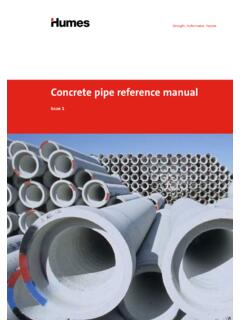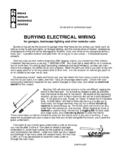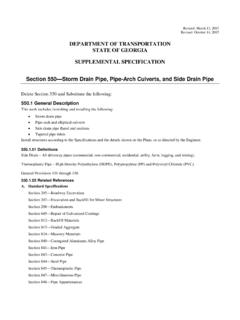Transcription of Box culverts - holcim.com.au
1 Box culverts Issue 2. Contents Introduction 1. Applications 2. Benefits of precast box culverts 2. Design information 3. Hydraulic design 3. Structural design 3. Multi-cell installations 4. Link Slab units 4. Splayed box culverts 6. Precast headwalls 6. Handling and installation 7. Jointing 7. Base rebates 7. Handling of culverts 7. Placing and backfilling 7. Precast solutions 8. Contact information 9. Introduction Box culverts This brochure provides general information for both Figure 1 Box culvert terminology Bottom: Precast concrete the specifier and user with only nominal dimensions box culverts and shown. Specific dimensions of box culverts vary Link Slab units Lid from state to state in Australia. When designing projects, reference should be made to the separate box culvert dimensions chart which is distributed Base by Humes in each state. Box culverts are available either as an inverted U on a concrete base foundation (crown unit) or as a U shaped Crown unit Invert unit trough with a lid (invert unit), see Figure 1.
2 Humes designs and supplies precast bases and lids to suit individual culverts as well as Link Slab units for Link Slab . multi-cell installations. Humes also manufacture Uniculvert modules where the crown and the base are cast integrally minimising site work and construction time. Multi-cell installation using Link Slab unit Following recommendations given in the Australian Standard, large box culverts are specified by size class and load class ie: a 2,700 mm span x 1,500 mm leg used under 2 m of fill and Austroads vehicle loading is specified as class 2715/2-A. Box culverts 1. Applications Benefits of precast box culverts Bottom: Box culverts are ideal for the following applications: Wide flows with low head High specification box culverts for Box culverts are ideal for flows where hydraulic head Instant bridging a high overfill is limited. For an equivalent waterway area to circular application Humes box culverts are designed to support the pipes, box culverts can be configured to have less SM 1600 road traffic loads as defined in AS 5100.
3 Impact on upstream water levels and downstream even when there is no overfill in place. Manufactured flow velocities than equivalent pipe structures. under quality assurance procedures, precast box culverts provide instant bridging with minimum Instant bridging traffic disruption. Precast construction means that traffic may use the installation immediately after placing and backfilling Drainage structures with limited fill height whereas in-situ construction will require a period for The shape and sizing of box culverts makes them ideal curing prior to stripping forms ready for use. Due to for drainage structures, in applications where cover to their ability to tolerate heavy wheel loads even with finished surface level is limited. no overfill in place, precast box culverts are superior Pedestrian, fauna and stock crossings to most alternative systems which require compacted Apart from hydraulic applications, the shape and overfill in place before loading is applied.
4 Sizing of precast box culverts means they are also Difficult site conditions eminently suitable as pedestrian subways and When site conditions are difficult, particularly where fauna/stock crossings under road and rail applications. excavation is in rock, installation of a box culvert Industrial applications requires minimal excavation and backfill. Humes box culverts have been extensively used as ducting for electrical cabling, steam, air, hot water and oil as well as emergency/fire exits. 2 Box culverts Design information Box culverts Hydraulic design Structural design Box culverts are commonly used as a conduit under While some authorities have their own specific structural roadways or railways. Hydraulic designs of such requirements for box culverts , the minimum design structures involve: standards for box culverts are contained in Australian Standard AS 1597 Part 1, for culverts up to and including evaluation of peak design flow rate 1,200 mm span and AS 1597 Part 2 for culverts from selection of culvert shape 1,500 mm to 4,200 mm span.
5 Determination of operating condition of culvert, that is whether flow through the culvert is controlled by inlet Box culverts are normally designed for the standard or outlet conditions highway vehicle loads or railway load requirements of check of outlet velocity (erosion or siltation conditions). the AS 5100 bridge design code, as appropriate for the application. However they can also be used in many The Concrete Pipe Association of Australasia (CPAA). non-standard applications and can be designed to carry manual, Hydraulics of Precast Concrete Conduits has loads well in excess of normal highway loading. It is been prepared to assist professional engineers with the important to note that construction considerations on hydraulic design of precast concrete conduits. site may require that heavy equipment must travel over box culverts before soil cover is placed. This can result It is recommended that this CPAA manual be used when in loading conditions more severe than those expected determining waterway areas for specific flow conditions.
6 In service. The design must satisfy construction conditions or provision must be made to support units during construction. Refer to AS 1597 Part 2 for minimum depths of fill for construction vehicle axle loads. Table 1 Small box culvert size range Span (mm). Leg height (mm) 300 450 600 900 1,200. 300 . 450 . 600 . 900 . 1,200 . Notes: 1. Nominal standard sizes are shown as: . 2. Box culverts are generally available in standard lengths of m and m (or m and m in QLD). 3. The size range of Humes standard box culverts up to 1,200 mm span are those included in Australian Standard 1597 Part 1. 4. In many cases Humes has the facility to manufacture larger span and leg heights beyond those indicated in the Australian Standards. Our design team can customise culvert designs to suit various applications and site conditions. - Not typically supplied. Box culverts 3. Multi-cell installations Top: Where box culverts are laid side-by-side in multi-cell Multi-cell installation of installations, they may be placed either touching or with box culverts a gap up to 25 mm which should be grouted.
7 Bottom: Multi-cell Actual requirements vary and are generally governed by installation using LinkSlab units the size of the culvert, site conditions and the standard adopted by the particular authority. The gaps should be grouted with a sand-cement mortar or equivalent for a minimum depth of at least the crown thickness as detailed in the Australian Standards for box culverts . Care must be taken with long leg culverts not to use excessive compaction, as forces may induce a loading in excess of normal design loading. Link Slab units Linkslab units spanning between two box culvert crown units are a cost effective solution for installations of three cells and above. Using Link Slab units also provides a greatly increased waterway area by enabling less restriction to water entering the culvert than is the case with multiple crown units side-by-side. A Linkslab unit usually has the same span as the supporting crown unit but Humes can design greater spans where required.
8 When depth of fill is minimal, a Linkslab unit can be designed to sit flush with the top of the crown unit. 4 Box culverts Figure 2 General layout of a multi-cell installation using Link Slab units Box culverts Cored holes in crown and Link Slab unit Mortar pad 10 mm Steel dowel bar grouted after assembly Overall Link Slab span Crown unit 180 mm (typical). Link Slab unit See enlarged detail Clear span (crown unit) Clear span (Link Slab unit). Table 2 Large box culvert size range Span (mm). Leg height (mm) 1,500 1,800 2,100 2,400 2,700 3,000 3,300 3,600. 600 . 900 . 1,200 . 1,500 . 1,800 . 2,100 . 2,400 . 2,700 . 3,000 . 3,600 . Notes: 1. Nominal standard sizes are shown as: . 2. Box culverts are generally available in standard lengths of m and m (or m and m in QLD). 3. The Humes large box culvert size range includes those sizes greater than 1,200 mm span and up to 4,200 mm span covered by Australian Standard 1597 Part 2.
9 4. In many cases Humes has the facility to manufacture larger span and leg heights beyond those indicated in the Australian Standards. Our design team can customise culvert designs to suit various applications and site conditions. - Not typically supplied. Box culverts 5. Splayed (skewed) box culverts Right: Splayed units are normally used in the following Splayed box culverts situations: where a box culvert line passes under a road or railway at skewed angles from 15 to 25 . where a box culvert line changes direction. In each situation, minimum length of the splayed unit is 1,000 mm. There are a number of possible plan layouts which can be adopted depending on culvert size, number of cells, road (or railway) width and skewed angles, see Figure 3. Splayed units are non-stock items; contact a Humes representative regarding availability. Figure 3 Typical two cell box culvert layout of skewed angles up to 25.
10 Precast headwalls Dir Direction of stream ect Precast concrete headwalls can be manufactured i tra on of ffic 1,000 mm to suit site requirements and offer significant minimum advantages over in-situ concrete, including: th wid reduced installation time ad ll ro fewer people on site era no premix concrete required so remote sites are Ov not an issue concrete is at strength when delivered. Single cell headwall Multi-cell headwall 6 Box culverts Handling and installation Box culverts Jointing Placing and backfilling Joints between box culverts used in stormwater drainage Large box culverts should be installed in accordance with conditions do not normally require a watertight seal. AS 1597 Part 2. Box culverts are usually made with plain ends giving a butt joint with the joint gap nominally 10 mm. The excavation, foundation preparation, placing of units, compaction and backfilling are all to be carried out in accordance with the relevant authority specification Base rebates document or box culvert Australian Standard.









